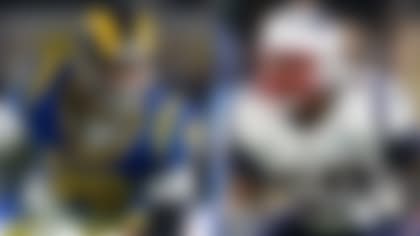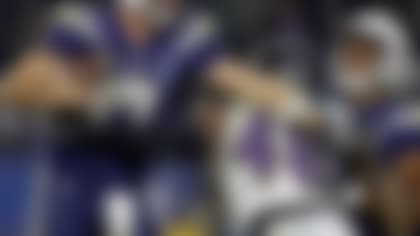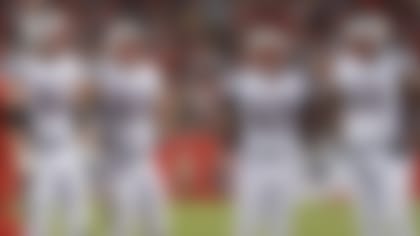A week after the disaster in Carson that included five interceptions and a 50-burger put on them, the Buffalo Bills rebounded with a close win over the Kansas City Chiefs, who appear to be up a creek without a paddle as we enter the final quarter of the regular season.
After opening the season with five straight wins, Kansas City has lost five of its last six, including three straight. Sunday's loss to the Bills would probably be the most concerning of the defeats, had the Chiefs not just inexplicably fallen to the now 2-9 New York Giants a week earlier.
In both losses, the same theme emerged: The Chiefs' offense has fallen apart.
Gone are the home runs hit by Tyreek Hill and Kareem Hunt. Gone are the deep shots taken by Alex Smith. In its place has been jammed up running lanes, incompletions and the end to a respectable interception-less streak.
Sunday was a continuation of such struggles. Kansas City saw immense pressure from one of the league's worst statistical defenses from very early on, with tackles Eric Fisher and Mitchell Schwartz struggling in the opening drive. The latter improved his play from there, cutting down on mistakes, but the former continued to have problems. The frequent pressure got to quarterback Alex Smith after just a quarter.
On this pass play early in the second quarter, a suddenly skittish Smith becomes panicked in a clean pocket, frantically stutter-stepping before firing a pass at the feet of fullback Anthony Sherman for a (surprising) gain of four yards.
Two plays later, Smith steps up in a fairly clean pocket (with the back end closing in on him) and elects to take off on a third-and-6, despite having multiple safety valves open. He comes up a couple yards short.
The Chiefs' offense only suffered from there in the first half, failing to execute much of anything thanks to an uncomfortable quarterback and a line that struggled mightily to block on zone plays. Fisher was as ineffective on a good amount of running plays as he was on pass plays. The tackle was responsible for this loss of yardage on a stretch play that didn't make it anywhere near the line of scrimmage.
One could vouch that center Mitch Morse should have had his head on more of a swivel, anticipating backside leakage, but peeling back to block a blitzing linebacker -- in this case, Matt Milano, who was shooting the A-gap after he recognized the play -- is a lot to ask in this situation. Meanwhile, Fisher was dominated by Bills edge rusher Jerry Hughes -- this will be a consistent theme in this piece -- who blew up the play in the backfield just before Milano arrived to clean it up.
Kansas City adjusted immediately in the second half, shifting from longer-developing plays to quick hitters on its first possession of the third quarter. The first play was a bubble screen to Travis Kelce for a gain of 10. A few plays later, on third-and-11, Smith found Kelce down the seam on a quick pass for a gain of 25 and a fresh set of downs. The next play, Smith threw a quick out to Demetrius Harris off a run fake for a 5-yard gain.
This is where Kansas City succeeded last season. With this offensive line, this might be the new ceiling, because Buffalo has provided future opponents with the blueprint to pressure Smith. Evidently, it doesn't take long to rattle the quarterback. Want to beat the Chiefs? Get to him early and watch the offense flounder from there.
Likely sensing Buffalo had adequately prepared, the Chiefs continued to open up the playbook in the second half, adding pre-snap motion to zone stretch plays and throwing in a jet sweep to Hill out of a heavy formation that included two tight ends lined up on the right and Albert Wilson brought in tight to the left. The intention: condense the defense to open up the perimeter. It worked, but it also was a sign of a concerning issue with the Chiefs -- it appears as though they don't trust their offensive line.
Honestly, they really shouldn't -- at least not the left side.
Fisher -- a former No. 1 overall pick -- hasn't exactly lived up to his billing in his time with Kansas City. It was on display in the first half against Buffalo, during which Fisher had a rough go of it against Hughes. A pair of consecutive plays illustrated exactly how confounded Fisher was with Hughes' different attacks.
Having been beaten a handful of times by Hughes' speed rush around the edge, Fisher adjusted, angling his pass drop slightly outward in anticipation of beating Hughes to the edge and meeting him there. It worked on a first-down completion to Demetrius Harris for a gain of 28, with extra credit due to Smith for sliding away from backside pressure before firing the pass.
On the very next play, Hughes adjusted. Fisher did not.
Fisher took the same angled pass drop, but Hughes took one step forward before quickly slanting inside, dipping and ripping while coming in contact with Fisher on his inside shoulder. Based on his drop and foot positioning, Fisher had already lost the battle.
The tackle attempted to turn his shoulders inside to salvage what he had of an engagement with Hughes, but it was too late. Assistance from left guard Zach Fulton (who had a fairly rough day himself) was in vain, as Hughes broke through the both of them and forced Smith to run away from the pressure, directly into Cedric Thornton for the sack. In a perfect world, Hughes gets credit for this sack, because he did all of the work.
Twice on the opening drive in the third quarter, Kansas City ran zone reads with the left end serving as the designated read man, meaning he'd go unblocked. That position was occupied by Hughes, who had a monster game up until this point. But for almost four minutes of game time, Hughes wasn't on the field -- and it showed.
Kansas City ran plays away from his replacement, Ryan Davis, executing the same zone read play twice in a row to the right while Davis stayed home. By the time Hughes returned, the Chiefs were inside Buffalo's red zone. They scored immediately, on a play-action bubble screen to Wilson for a 19-yard touchdown. It was yet another quick hitter that didn't even allow Hughes the time to get to Smith.
For those who were wondering, he won his battle -- but the ball was already thrown.
From there, it was downhill for the Chiefs' offense. They continued with their quick hitters, mixing in a couple of counters that went for insignificant gains, but the frustration and resulting desperation became clear when Kansas City starting digging deep into the playbook with bubble screens, plenty of pre-snap motion for misdirection purposes and some off-the-wall plays. At one point early in the fourth quarter on third-and-2, the Chiefs shifted Kelce behind center in a modified pistol/full house formation, running a zone read to the right that the tight end incorrectly read, resulting in a loss of three.
Who can realistically expect a tight end to read a defender properly in a rare situation, at NFL speed?
Here is where Chiefs fans should worry. Plays like this, and the defined shift to shorter passes are concrete examples of two changes in thinking from the coordinator box: Kansas City knows (or at least knew by halftime of Week 12) that it cannot rely on its line to protect Smith for three-plus seconds. It also knows the unit cannot block effectively enough to run anything outside of shotgun-based zone reads.
This shrinks Kansas City's offense back down to the 10-and-in, perimeter-based scheme it predominantly ran last season, which also gave us that painful, field-goal-filled AFC Divisional Round loss to Pittsburgh. But the Chiefs have less weapons at their disposal this time around, making it all that much more alarming.
It starts and ends with the offensive line. Should they protect well, Smith will have more time to attempt to stretch the field. But they'll also have to protect well enough to give him the confidence that he won't need to pull his eyes down and attempt to escape. That requires consistency, which is something the Chiefs currently don't have. They better get it quickly if they want to hang onto their perch atop the AFC West.











